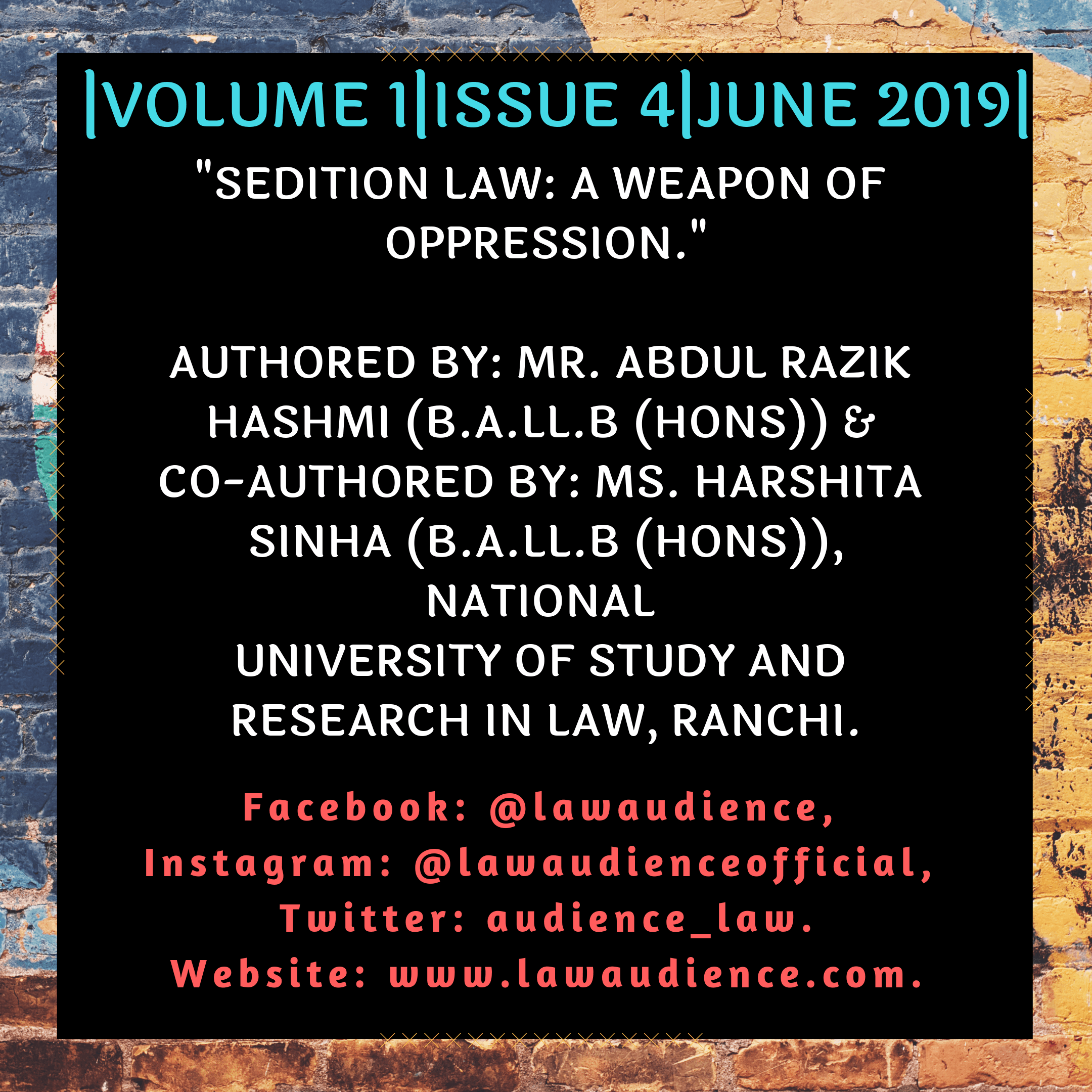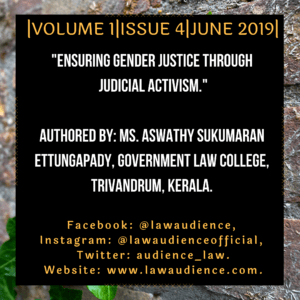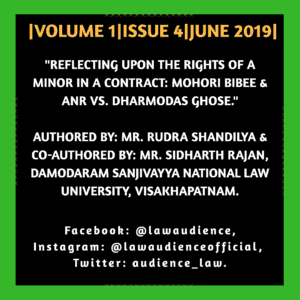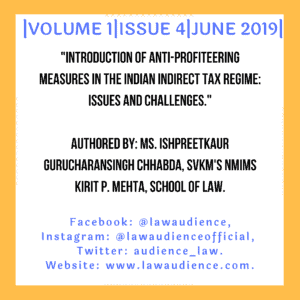Authored By: Mr. Abdul Razik Hashmi (B.A.LL.B (Hons), Co-Authored By: Ms. Harshita Sinha (B.A.LL.B (Hons), National University of Study and Research in Law, Ranchi.
“If there is any principle in the Constitution that more imperatively calls for attachment than any other, it is the principle of free thought- not only free thought of those who agree with us but freedom for the thought that we hate.”[1] –Justice Holmes.
I. INTRODUCTION:
All over the world the democratic form of government has been acclaimed as the best form of government but the problem with this stance is that there is no exact clarity on the term democracy, that’s why at many instances even autocrats and despots claim to be democratic. Unfortunately, this kind of undemocratic behaviour is still perceptible in our Indian society in the form of section 124A of Indian Penal Code which fails to follow the dictates of the modern democracy by curbing the freedom of speech and expression guaranteed by the constitution of India. Sedition law basically prohibits the words or conduct that is intended to incite the violence or hatred against the democratically elected government. Due to the vagueness of words of section 124A, it became a weapon in the hands of the political parties to curb the resenting voices. The recent cases highlight that how the ruling governments had used the Sedition Law as a tool to repress the voices against them and to harass the Opposition Activists, RTI Activists, Cartoonist, and Media Professionals which certainly poses a threat to freedom of speech and expression.
This research paper is divided into six parts. The Part I deals with the general introduction of the sedition law. In Part II we undertake to deal with the history of sedition in the Indian criminal law and highlight that how the sedition law has been evolved. In Part III we undertake to examine the difference between the advocacy and incitement by using the Austin’s Speech Acts theory and demonstrate how the sedition laws are subject to abuse due to the misunderstanding of the relation between speech and action. In Part IV we undertake to analyze the strained relationship between freedom of speech and sedition law. Part V examines the recent instances where sedition law has been used by the government to suppress political dissent. Finally, in Part VI, this research paper concludes that inherent undemocratic tendencies lie in section 124A, so it should be scrapped.
II. MEANING OF SEDITION UNDER SECTION 124A OF INDIAN PENAL CODE, 1860:
“Section 124A of the IPC as stands today reads “Whoever by words, either spoken or written, or by signs, or by visible representation, or otherwise, brings or attempts to bring into hatred or contempt, or excites or aims to excite disaffection towards, the government established by Indian law, shall be punished with imprisonment for life, to which fine may be added, or with imprisonment which may extend to three years, to which fine may be added, or with fine.”
Explanation 1:
The expression “disaffection” includes disloyalty and all feelings of enmity.
Explanation 2:
Comments expressing disapprobation of the measures of the Government with a view to obtain their alteration by lawful means, without exciting or attempting to excite hatred, contempt or disaffection, do not constitute an offence under this section.
Explanation 3:
Comments expressing disapprobation of the administrative or other action of the Government without exciting or attempting to excite hatred, contempt or disaffection, do not constitute an offence under this section.
III. HISTORY OF SEDITION LAW:
Thomas Macaulay introduced Section 113 of the Draft Penal Code, 1837-1839 which contained the provision of sedition but this was omitted in the Indian Penal Code, 1860. The law of Sedition that was included in 1870 was in the lines of the Treason Felony Act, 1848 of the United Kingdom. The very first case of this infamous law was in 1891 when the editor of the newspaper Bangobasi was charged under the law of sedition for criticizing the ‘Age of Consent Bill’.[2] The Amending Act of 1898 amended this section and added ‘Hatred’ and ‘Contempt’ along with disaffection in order to expand the scope of the law of sedition to curb the political dissent. Various eminent freedom fighters like Bal Ganga Dhar Tilak and Mahatma Gandhi were charged under this law. Bal Gangadhar Tilak in his newspaper Kesari carried an article in which he wrote that Shivaji woke up in heaven and lamented on the condition of our country. In the case of Queen Empress v. Bal Gangadhar Tilak[3], Justice Arthur Strachey said that for attracting Section 124A, the amount and intensity of disaffection are immaterial, if any person attempts to excite the feelings of disaffection, be it great or small; he would be liable under this Section. The strict rule of interpretation was applied in these cases and due to the strict interpretation of this section; the Nationalist leaders were repeatedly made the victim of this Draconian Law.
It can be inferred that the Amendment made in 1898 reflected the ideas of Justice Strachhey, however, a shift was made in the case of Niharendu Dutt Majumdar v. King Emperor[4]where the court drifted from the strict and literal interpretation of the Section 124A that was applied in the earlier cases. In this case, the court held that ‘public disorder and violation is the gist of the offences’.
However, the interpretation given in the case of King Emperor v. Sadashiv Narayan Bhalerao,[5] again reiterated the law stated in the case of Queen Empress v. Bal Ganga Dhar Tilak.[6] In 1947, Sardar Vallabhbhai Patel sought to include Sedition as a ground to restrict Fundamental Right to speech (Article 13) but K.M. Munshi vehemently opposed the inclusion of the word Sedition and proposed an amendment in the draft constitution and finally this ground was dropped by the framers of the Constitution in the final draft.[7] Pandit Jawaharlal Nehru also considered Sedition as ‘obnoxious and objectionable’[8], he was also of the opinion that this sedition law should no longer be the part of Indian Penal Code.
IV. ADVOCACY VS. INCITEMENT:
The spate of the sedition cases has made us ponder what actually constitutes a seditious offence. Is it the incitement or advocacy or both are the ingredients of the sedition and how far the advocacy is different from incitement. The distinction between incitement and advocacy is of utmost importance that we must need to consider because unless advocacy leads to incitement and violence our Constitution protects the advocacy of subversive or revolutionary ideas. So there is a thin line of distinction between advocacy and incitement but it is very important to know thin line because the former is constitutionally protected while the later may constitute an offence of sedition.
The Supreme Court in the case of Arup Bhuyan v. State of Assam[9] made the distinction between the advocacy of subversive ideas and incitement by drawing the line between passive and active membership. The court, in this case, set aside the conviction of the appellants who were charged under section 3(5) of the Terrorist and Disruptive Activities (Prevention) Act, 1987 which criminalised membership of a terrorist organization.
The judgment penned by the Justice Nariman in a very important and recent case of Shreya Singhal v. Union of India[10]differentiated between the advocacy and incitement. The scope of the individual’s right to express himself freely has been widened by the Apex Court and state’s power to restrict speech has been confined by declaring section 66A of the I.T Act, 2000 derogative of Article 19 of Constitution of India. The court held that it’s the incitement and not the advocacy that could be punished and for criminalising the words and phrases within the ambit of section 124A one has to prove that these words and phrases are actually used for inciting the mob for violent actions. The U.S. Supreme Court in order to stifle the abuse of the sedition law had developed the direct incitement test in the case of Bradenburg v. Ohio[11]under which certain criteria must be met to penalise someone under sedition law. Under this test seditious offence could only be evoked when the speech is accompanied by some other conduct and speech in its own is insufficient to evoke the seditious offence.
So the inference that can be drawn from this judgment is that sedition itself as a category of offence is irrelevant if the speech leads to some action (an action that falls under the category of general criminal offences, incitement, and other public offences) and if there are criminal laws in place to prohibit such offences, then sedition laws are unnecessary[12].
Sedition law is based on the J.L Austin philosophy[13] that all speech is a type of action that’s why speech alone can be criminalised irrespective of the fact that whether an actual violation has been caused or not. So according to Austin’s theory, certain types of words should be punished without considering their consequences because they are dangerous in themselves[14], but this philosophy justifying the sedition law is based on the misunderstanding of the relation between the speech and action.
The authors here want to argue that all the speeches do not have the power to produce effects, in a narrow sense all speech acts as conduct but it is not necessary that all speeches have the potential to initiate the set of consequences. So two conditions have to be met before penalising someone for their speech under sedition law: (1) the person must have been in a certain position of authority, (2) uttered words must have to occur in a particular context by the person.[15]
From the above discussion, we can draw a conclusion that there is a difference between advocacy of subversive ideas and incitement although there is a thin line of distinction between them but a clear cut demarcation has to be made between them. The justification given by the supporters of the sedition law that all speeches are themselves an action and have to be punished without considering their consequences is based on the weak arguments because not all speeches constitute an action. The sedition law overlooks the particular situational context and is tool devised by the colonisers which have been used currently by the ruling government to silence the political dissent.
V. SEDITION LAW AND FREEDOM OF SPEECH: A STRAINED RELATIONSHIP:
Article 19(1) of the Constitution of India recognised the freedom of speech and expression as one of the fundamental rights of every citizen. The philosophy underlying this article is that every person has autonomy over their views and for the democratic self-governance and proper functioning, freedom of speech and expression is necessary irrespective of the fact how unpopular those viewpoints are. Freedom of speech and expression also includes the freedom to criticise the government and its policies but whenever questions were asked on the freedom of speech and expression, the leaders of India many times cite diverse and vocal civil society as proof of strength of India’s democracy, however, the reality is something different and the draconian laws like sedition law, to stifle the dissent, were systematically used by the ruling party. Sedition law does not meet the end of justice and the public interest because inherent undemocratic tendency lies in this law which offends the freedom of speech and expression which is the benchmark of our democracy and secures the privileged position of the ruling government similar to those of our tyrannical British rulers. This archaic sedition law in its current form is harsh and excessively vague in nature due to which it is more prone to indiscriminate use by the central and the state government against the people who have the dissenting voices.
Freedom of speech and expression is very necessary for a mature democracy because it acts as a safety valve; it provides opportunities to the opponent speaker to express his opinion which if suppressed continuously by the ruling government through the use of sedition law can take the form of gargantuan evil.
VI. JUDICIAL VIEW ON SEDITION LAW:
Sedition law in India can be viewed as a hangover of the colonial regime and it is not needed in the present scenario. A law of Sedition which was thought necessary during the colonial period has become inappropriate by the change that has come about and it can be seen that the government can come and go without affecting the foundation of the State.[16] The vague language of this law is couched in the broadest possible manner so as to include a wide range of activities. Since the framing of the Constitution, the constitutional validity of this section has been considered by the Supreme Court on various occasions.
The Apex Court in the case of Kedar Nath Singh v. State of Bihar[17] held that Section 124 A of the Indian Penal Code is constitutional in nature and put the judicial ambivalence to rest. However, the Supreme Court has laid down certain limitations and emphasised on a liberal understanding of this law. Supreme Court curtailed this law only to those acts that can cause public disorder and violence and the words that criticise the present government, however harsh it may be, cannot be subjected to this law. This case also distinguished between the ‘government established by law’ and the ‘persons for the time being engaged in carrying out the administration’. The former can be said to be the representation of State and the latter one means the criticism of the government officials and their policies. So, any criticism of the government officials with regard to the functioning of the government would not amount to sedition and only those actions that jeopardise the existence of the state can only amount to sedition. This judgment is somehow, impractical in its approach as the officials of the government or any representative of the people in government can also be considered as the representation of the State and hence, this distinction is dubious in its nature.[18]
Supreme Court has further cautioned on the mechanical order of conviction under this section against the citizens of the country. It had put light on the conviction recorded by the trial court that evinced the negligence on their part and advised the courts to be more careful while deciding the cases of serious nature.[19] In the case of V.A. Pugalenthi v. State[20], Madras High Court stated that taking action against peaceful protest or dissent would not lead to seditious act as citizens have the fundamental right to demonstrate their protest peacefully. There can be different opinions and viewpoints of an event as democracy cannot be said to be another name of majoritarianism. In a democracy dissenting and critical viewpoints should also be acknowledged in an addendum to viewpoints which constitute the majority.
Freedom of speech makes democracy vibrant. Until and unless there is some threat to the public order suppressing the freedom of speech and expression is against the spirit of the democracy. The same was reiterated by the court in Cellular Operators Association of India & Ors. v. Telecom Regulatory Authority of India[21] that right to information is an inseparable part of freedom of speech guaranteed under Article 19(1)(a) of Constitution of India and both cannot be seen in isolation with each other.
Criticism or strong condemnation of the state or of the institutions of state does not amount to sedition. The same was reiterated by the Allahabad High Court in the case of Arun Jaitley v. State of U.P.[22] that criticism of a judgment of Supreme Court on the National Judicial Appointment Commission does not amount to sedition.
The lower court convicted the activist Binayak Sen, Narayan Sanyal and Piyush Guha on the charge of sedition. The High Court upheld the conviction which was erroneous as it can be contended that this judgment violated the rules that were laid down in the case of Kedar Nath Singh v. State of Bihar[23] which laid down that the speech must have led to the incitement of public disorder and violence. Section 124 A of Indian Penal Code must have to be read in the light of letter and spirit of the constitution of India.
Even though the Supreme Court has laid down certain guidelines to restrict the misuse of this law, but this law is being used as a tool for the government to browbeat those who are opposed to it.[24] The United Nations Special Rapporteur in his 2010 annual report commented on the frequent phenomenon of nations using laws as political tools; limiting freedom of expression arbitrarily in order to silence dissent or criticism.[25] It can also be seen from the recent incidents that the government has been using this law against those who question the laws and policies of the government. Recently, Assamese scholar Dr. Hiren Gohain along with Akhil Gogoi, leader of Krishak Mukti Sangram Samiti and activist leader Manjit Mahanta was booked by the police under the law of sedition for criticising the Citizenship (Amendment) Bill, 2016.[26] The filing of chargesheet against former student union leaders Kanhaiya Kumar, Umar Khalid, and eight others for allegedly holding an event in which ‘anti-national’ slogans were raised have sparked debates and pontification by leaders around the country.[27] A man named Krishnendu Debbarma from Tripura was charged under sedition for a social media post related to the Pulwama Terror attack.[28] Fourteen students from Aligarh Muslim University were booked under Sedition for allegedly raising ‘anti-national’ slogans in the campus. However, the charge against them was dropped as there was no evidence supporting the claim.[29] These incidents are the glaring examples of the misuse of this section.
VII. CONCLUSION:
In a democracy, singing from the same songbook is not a benchmark of patriotism.[30] Sedition law is a piece of legislation which is oppressive in nature and posits the series of problems to modern democracy[31]. In order to be in consonance with the modern form of democracy, sedition law which is originated by the tyrannical British rulers before the emergence of democracy to stifle the dissenting voices should now be scrapped. Taking the example of England, where this law was repealed ten years ago, it can be argued that the relevance of the law of sedition is waning in the present scenario. The existing scenario of the laws of sedition shows the non-uniformity and uncertainty regarding the extent to which we can use our freedom of speech and criticise the policies of the existing government.
The Law Commission submitted its consultation paper on Sedition headed by former Supreme Court judge Justice B.S. Chauhan who opined for examining the existing nature of sedition law.[32] The penal provisions present in any statue have justifications for the same and that justifications can be traced from the values enshrined in the Constitution of India but the laws on sedition are having more undemocratic tendency due to their vagueness and non-uniform application of this law. As there can be no democracy without dissent, so sedition law should now be repealed.
[1] United States v. Schwimmer, 279 U.S. 644 (1939) (Holmes, J., Dissenting).
[2] Sougata Talukdar & Rakesh Mondal, Law of Sedition: An agent of Colonialism: A Crtique, 3(3) Int’l J.L. 21, 22 (2017).
[3] (1898) I.L.R. 22 Bom. 112 (India).
[4] A.I.R. 1942 F.C. 22 (India).
[5] (1947) L.R. 74 I.A. 89 (India).
[6] (1898) I.L.R. 22 Bom. 112 (India).
[7] Siddharth Narrain, Disaffection and the Law : The Chilling Effect of Sedition Laws in India, 46(8) Econ. Pol. Wkly 33,35 (2011).
[8] Id.
[9] (2011) 3 S.C.C. 377 (India).
[10] A.I.R. 2015 S.C. 1523 (India).
[11] 395 U.S. 444 (1969).
[12]Sarah Sorial, Sedition and the question of freedom of speech, Current Issues in Criminal Justice (Feb. 2, 2019, 12:05 P.M), http://ro.uow.edu.au/artspapers/1668/.
[13] J. L. Austin, How To Do Things With Words (Harvard University Press, 1st ed.) (1962).
[14] Aishwarya Narayanan, A Theoretical Analysis of the Law on Sedition in India, 4(1) Christ University L.J. 87,101 (2015).
[15] Sarah Sorial, Can Saying Something Make it So? The Nature of Seditious harm, 29 Law and Philosophy 273, 305 (2010).
[16] Tara Singh v. State, A.I.R. 1951 S.C. 44 (India).
[17] A.I.R. 1962 S.C. 955 (India).
[18] RA Nelson, Indian PenaL code 665 (S.K. Sarvaria, 2008).
[19] Bilal Ahmed Kaloo v. State of Andhra Pradesh, A.I.R. 1997 S.C. 3483.
[20] Crl. O.P. No. 21463 of 2017, decided on 9/11/2017.
[21] A.I.R. 2016 S.C. 2336 (India).
[22] 2016 (1) A.D.J.76 (India).
[23]A.I.R. 1962 S.C. 955 (India).
[24] Jitendra Singh, Kapil Sibal wants to scratd tap colonial era sedition law : Everything you need to know about the stringent law, Times Now News, (Feb. 3 , 2019, 3:00 PM), https://www.timesnownews.com/india/article/the-sedition-law-in-india-chargsheet-against-kanhaiya-kumar-draconian-law-of-colonial-time-arundhati-roy-binayak-sen-asim-trivedi/349385.
[25] Margaret Stride, Not a 21st Century Law, Tehelka (Feb. 15, 2019, 10:09 AM), http://old.tehelka.com/not-a- 21st-century-law/.
[26] Sadiq Naqvi, Assam police slap sedition charges on Hiren Gohain, Akhil Gogoi at meeting against sedition bill, Hindustan Times, (Feb. 20, 2019, 4:00 PM), https://www.hindustantimes.com/india-news/assam-police-slap-sedition-charges-on-hiren-gohain-akhil-gogoi-at-meeting-against-citizenship-bill/story-cMjae3sdBDxVbPrnDvSqpK.html.
[27] India Today web desk, JNU Sedition case: Kanhaiya Kumar, Umar Khalid and 8 others to be charges today, India Today, (Feb. 20, 2019, 4:15 PM), https://www.indiatoday.in/india/story/jnu-sedition-case-chargesheet-kanhaiya-kumar-umar-khalid-1430284-2019-01-14.
[28] Debraj Deb, Sedition case against Tripura man over ‘anti-India’ online post, The Indian Express, (Feb. 21,2019, 5:00 PM), https://indianexpress.com/article/north-east-india/tripura/sedition-case-against-tripura-man-over-anti-india-online-post-5598473/.
[29] Press Trust of India, Sedition charges against AMU students dropped, The Hindu, (Feb. 21, 2019, 5:00 PM), https://www.thehindu.com/news/national/other-states/sedition-charge-against-amu-students-dropped/article26345039.ece.
[30]Krishnadas Rajagopal, Law Commission calls for re-think on sedition clause, The Hindu, (Feb.20, 2019, 5:15 PM), https://www.thehindu.com/news/national/law-commission-backs-dissent-in-a-democracy/article24822850.ece.
[31]Tonnie O Iredia, Trends In Sedition Laws: Implications For The Practice of Journalism in Developing Societies, 23 IOSR-JHSS, 44-49 (2018).
[32] Rajagopal, supra note 26.



